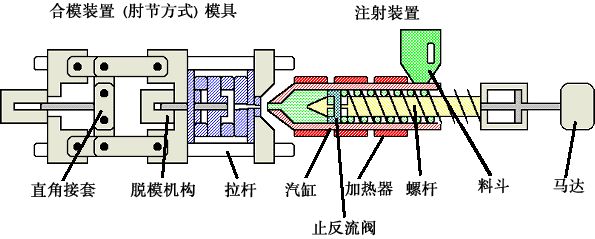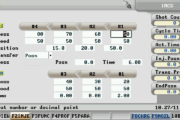
The injection molding process refers to a process of producing a semi-finished part of a certain shape by pressing, injecting, cooling, and detaching the molten raw material.
The injection molding process of plastic parts mainly includes six stages of clamping–filling—gas-assisted, water-assisted pressure-cooling-opening—release.
1. Filling stage
Filling is the first step in the entire injection molding cycle, from the time the mold is closed to the injection, until the mold cavity is filled to approximately 95%. In theory, the shorter the filling time, the higher the molding efficiency; but in actual production, the molding time (or injection speed) is subject to many conditions.
High speed filling. When the high-speed filling is performed, the shear rate is high, and the plastic has a viscosity drop due to shear thinning, so that the overall flow resistance is lowered; the local viscous heating effect also makes the thickness of the solidified layer thin. Therefore, in the flow control phase, the filling behavior often depends on the volume to be filled. That is, in the flow control stage, due to the high-speed filling, the shear thinning effect of the melt tends to be large, and the cooling effect of the thin wall is not obvious, so the utility of the rate prevails.
Low speed filling. When heat conduction controls low-speed filling, the shear rate is low, the local viscosity is high, and the flow resistance is large. Due to the slower rate of replenishment of the hot plastic, the flow is slower, so that the heat conduction effect is more obvious, and the heat is quickly taken away by the cold mold wall. With a small amount of viscous heating, the thickness of the solidified layer is thicker, which further increases the flow resistance at the thinner portion of the wall.
Due to the flow of the fountain, the plastic polymer chains in front of the flowing waves are directed to the almost parallel flow wavefront. Therefore, when the two plastic melts meet, the polymer chains of the contact faces are parallel to each other; plus the two melts have different properties (different residence time in the cavity, temperature and pressure are different), resulting in the fusion zone of the melt. Microscopically, the structural strength is poor. When the parts are placed at an appropriate angle under light, they are visually observed, and it is found that a significant bonding line is produced, which is the formation mechanism of the weld lines. The weld line not only affects the appearance of the plastic part, but also has a loose microstructure, which tends to cause stress concentration, so that the strength of the part is lowered and fracture occurs.
In general, the strength of the weld line which is welded in the high temperature region is good. Because of the high temperature, the polymer chain is relatively better, and it can penetrate and entangle each other. In addition, the temperature of the two melts in the high temperature region is relatively close, and the thermal properties of the melt are almost the same, which increases the strength of the welded region; In the low temperature region, the welding strength is poor.
2. Pressure keeping stage
The role of the packing phase is to continuously apply pressure, compact the melt, and increase the density (densification) of the plastic to compensate for the shrinkage behavior of the plastic. During the pressure holding process, the back pressure is high because the cavity is filled with plastic. During the pressure-preserving compaction process, the screw of the injection molding machine can only slowly move forward slightly, and the flow speed of the plastic is also slow. The flow at this time is called pressure-holding flow. Since the plastic is accelerated and solidified by the mold wall during the pressure holding stage, the melt viscosity is also increased rapidly, so the resistance in the mold cavity is large. In the later stage of pressure keeping, the material density continues to increase, and the plastic parts are gradually formed. The pressure holding stage is continued until the gate is cured and sealed. At this time, the cavity pressure in the pressure holding stage reaches the highest value.
During the holding phase, the plastic exhibits partially compressible properties due to the relatively high pressure. In the higher pressure areas, the plastic is denser and has a higher density; in the lower pressure areas, the plastic is looser and the density is lower, thus causing the density distribution to change with position and time. The plastic flow rate during the pressure holding process is extremely low, and the flow no longer plays a leading role; the pressure is the main factor affecting the pressure holding process. During the packing process, the plastic has filled the cavity, and the gradually solidified melt acts as a medium for transmitting pressure. The pressure in the cavity is transferred to the surface of the mold wall by means of plastic, which has a tendency to open the mold, so that a suitable clamping force is required for the mold clamping. The mold-up force will slightly open the mold under normal conditions, which will help the exhaust of the mold; however, if the mold-up force is too large, it will easily cause the molded product to burr, overflow, and even open the mold. Therefore, when selecting an injection molding machine, an injection molding machine with a large enough clamping force should be selected to prevent the mold from rising and to effectively maintain the pressure.
Under the new injection molding environment, we need to consider some new injection molding processes, such as gas-assisted molding, water-assisted molding, and foam injection molding.
3. Cooling stage
In injection molding dies, the design of the cooling system is very important. This is because the molded plastic product can only be cooled and solidified to a certain rigidity, and the plastic product can be prevented from being deformed by external force after demolding. Since the cooling time accounts for about 70% to 80% of the entire molding cycle, a well-designed cooling system can significantly reduce molding time, increase injection productivity, and reduce costs. Improperly designed cooling systems can lengthen the molding time and increase the cost; uneven cooling will further cause warpage of plastic products.
According to the experiment, the heat from the melt entering the mold is roughly distributed in two parts, and a part of 5% is radiated and convected to the atmosphere, and the remaining 95% is conducted from the melt to the mold. In the mold, due to the action of the cooling water pipe, the heat is transferred from the plastic in the cavity to the cooling water pipe through the heat transfer through the mold frame, and then carried away by the cooling liquid through the heat convection. A small amount of heat that is not carried away by the cooling water continues to conduct in the mold, and then escapes into the air after contacting the outside.
The molding cycle of injection molding consists of clamping time, filling time, holding time, cooling time and demolding time. Among them, the cooling time accounts for the largest proportion, about 70% to 80%. Therefore, the cooling time will directly affect the length of the plastic product molding cycle and the size of the production. During the demolding stage, the temperature of the plastic product should be cooled to a temperature lower than the heat distortion temperature of the plastic product to prevent the plastic product from being loosened due to residual stress or warping and deformation caused by the external force of the demolding.
Factors affecting the cooling rate of the product are:
(1) Plastic product design. Mainly the wall thickness of plastic products. The greater the thickness of the product, the longer the cooling time. In general, the cooling time is approximately proportional to the square of the thickness of the plastic article or proportional to the 1.6th power of the maximum runner diameter. That is, the thickness of the plastic product is doubled, and the cooling time is increased by 4 times.
(2) Mold material and its cooling method. Mold materials, including mold cores, cavity materials, and formwork materials have a large impact on cooling rates. The higher the heat transfer coefficient of the mold material, the better the heat transfer from the plastic per unit time and the shorter the cooling time.
(3) Cooling water pipe configuration. The closer the cooling water pipe is to the cavity, the larger the pipe diameter, the greater the number, the better the cooling effect, and the shorter the cooling time.
(4) Coolant flow rate. The greater the flow rate of cooling water (generally to achieve turbulent flow), the better the effect of cooling water to remove heat by heat convection.
(5) The nature of the coolant. The viscosity and thermal conductivity of the coolant also affect the heat transfer of the mold. The lower the viscosity of the coolant, the higher the heat transfer coefficient and the lower the temperature, the better the cooling effect.
(6) Plastic selection. Plastic refers to a measure of the rate at which plastic conducts heat from a hot ground. The higher the heat transfer coefficient of plastic, the better the heat transfer effect, or the lower specific heat of plastic, the temperature is easy to change, so the heat is easy to dissipate, the heat conduction effect is better, and the required cooling time is shorter.
(7) Processing parameter setting. The higher the material temperature, the higher the mold temperature, the lower the ejector temperature, and the longer the cooling time required.
Design rules for the cooling system:
(1) The designed cooling passage should ensure that the cooling effect is uniform and rapid.
(2) The purpose of designing the cooling system is to maintain proper and efficient cooling of the mold. Cooling holes should be of standard size for ease of processing and assembly.
(3) When designing the cooling system, the mold designer must determine the following design parameters according to the wall thickness and volume of the plastic part: the position and size of the cooling hole, the length of the hole, the type of the hole, the configuration and connection of the hole, and the coolant Flow rate and heat transfer properties.
4. Ejection stage
Demolding is the last step in an injection molding cycle. Although the product has been cold-formed, the demoulding has a very important influence on the quality of the product. Improper demolding may result in uneven force during demolding and deformation of the product when it is ejected. There are two main ways of demolding: demolding of the ejector and demolding of the stripper. When designing the mold, choose the appropriate release method according to the structural characteristics of the product to ensure the product quality.
For the mold with demoulding demoulding, the setting of the ejector should be as uniform as possible, and the position should be selected at the place where the demoulding resistance is the largest and the strength and rigidity of the plastic parts are the largest, so as to avoid deformation and damage of the plastic parts.
The stripper plate is generally used for the deep cavity thin-walled container and the release of the transparent product which does not allow the trace of the putter. The mechanism is characterized in that the stripping force is large and uniform, the movement is stable, and there is no obvious residual trace.









